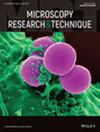Adaptive block imaging based on compressive sensing in AFM
Abstract
Atomic force microscopy (AFM) is a kind of high-precision instrument to measure the surface morphology of various conductive or nonconductive samples. However, obtaining a high-resolution image with standard AFM scanning requires more time. Using block compressive sensing (BCS) is an effective approach to achieve rapid AFM imaging. But, the routine BCS-AFM imaging is difficult to balance the image quality of each local area. It is easy to lead to excessive sampling in some flat areas, resulting in time-consuming. At the same time, there is a lack of sampling in some areas with significant details, resulting in poor imaging quality. Thus, an innovative adaptive BCS-AFM imaging method is proposed. The overlapped block is used to eliminate blocking artifacts. Characteristic parameters (GTV, Lu, and SD) are used to predict the local morphological characteristics of the samples. Back propagation neural network is employed to acquire the appropriate sampling rate of each sub-block. Sampling points are obtained by pre-scanning and adaptive supplementary scanning. Afterward, all sub-block images are reconstructed using the TVAL3 algorithm. Each sample is capable of achieving uniform, excellent image quality. Image visual effects and evaluation indicators (PSNR and SSIM) are employed for the purpose of evaluating and analyzing the imaging effects of samples. Compared with two nonadaptive and two other adaptive imaging schemes, our proposed scheme has the characteristics of a high degree of automation, uniformly high-quality imaging, and rapid imaging speed.
Highlights
- The proposed adaptive BCS method can address the issues of uneven image quality and slow imaging speed in AFM.
- The appropriate sampling rate of each sub-block of the sample can be obtained by BP neural network.
- The introduction of GTV, Lu, and SD can effectively reveal the morphological features of AFM images.
- Seven samples with different morphology are used to test the performance of the proposed adaptive algorithm.
- Practical experiments are carried out with two samples to verify the feasibility of the proposed adaptive algorithm.

 求助内容:
求助内容: 应助结果提醒方式:
应助结果提醒方式:


